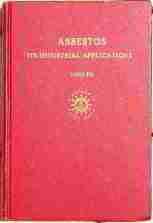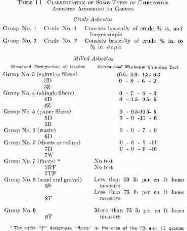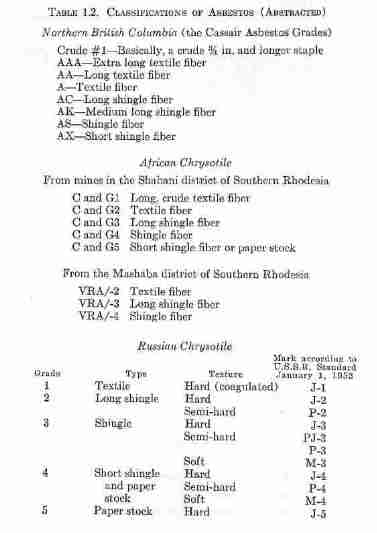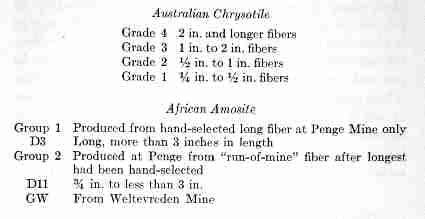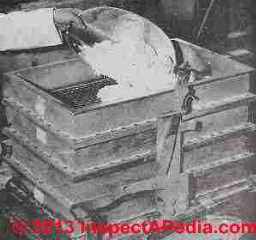 Asbestos Classifications
Asbestos Classifications
by Fiber length & properties
- POST a QUESTION or COMMENT about what building materials may contain asbestos, visual identification of asbestos-containing materials in buildings, and possible asbestos material identification by testing, use, age, appearance
Asbestos classes:
How was asbestos material classified for purposes of manufacturing asbestos-containing products: classifications of raw or mined asbestos ore, fibers, or dust. Here we describe the standard asbestos product material classes that were based on fiber length and other properties.
This articles series about the manufacture & use of asbestos-containing products includes detailed information on the production methods, asbestos content, and the identity and use of asbestos-containing materials.
InspectAPedia tolerates no conflicts of interest. We have no relationship with advertisers, products, or services discussed at this website.
Asbestos Classification Methods
Grading of asbestos is generally (lone on the basis of length rather than on quality. The qualities winch are important to the fibers are flexibility and fineness. The more flexible and fine fibers are used for spinning and weaving textile products. The shorter milled fibers are used in such varied products as asbestos-cement and tile.
[Click to enlarge any image]
The Canadian Asbestos Producers' have set up what is referred to as the Quebec Standard Asbestos Testing Machine for classifying milled asbestos. This method is based on the mechanical sieving of fibers. There has been a general trend to adopt the Canadian Standards Classification; however, many of the mines in Canada still retain their own methods which are specifically tailored to their customers. The classification divides chrysotile into two main classes— crude and milled asbestos.
The crude asbestos consists of the hand selected crossveining material essentially in its native or unfiberized form. Its length can be determined by combing. Milled asbestos consists of all grades produced by the mechanical treatment of asbestos ore. These two main divisions are subdivided into different groups ranging from group No. 1 to No. 9. Some of these groups are listed in Table 1.1. [Click to see an enlarged, detailed version of this table]
Table 1.1. Classification of Some Types of Chrysotile Asbestos According to Groups
The Quebec Standard Asbestos Testing Machine consists of three stacked screens and a pan which rests on a table. See Figure 1.3. These screens are driven by an eccentric gear so that an elliptical motion is produced on the screens. Each screen measures 24½ in. by 144 in. with each of the boxes being 3 1/2 in. in depth. The top box which is identified as box 1 consists of a wire screen with 1/9 in. openings, box 2 has a 4-mesh wire, box 3 has a 10-mesh wire and box 4 is a closed receptacle which collects all matter filtered through the other three boxes. The motion of the boxes and the time that the fibers are subjected to that motion are fixed.
Figure 1.3 (at left) Quebec Standard Asbestos Testing Machine. (Courtesy Johns Manville Corp.)
The test procedure is such, that it introduces 16 oz. of asbestos on the top tray. After two minutes of motion, the fiber in each tray is weighed. The more fiber retained on the first screen and the less fiber falling into the pan the higher the grade of product. As an example Group No. 3D specifies 10.5-3.9-1.3-0.3.
The greatest increase in the use of fibers has been in the shorter lengths that comprise approximately 50 per cent of Canadian asbestos production. The classification of shorts and floats follows the same principle of the shaker test; however, other factors such as bulk, grit percentage, and viscosity are involved.
The term refuse is a railway freight classification; it does not mean that shorts and floats are byproducts of asbestos milling. As the names imply, floats and shorts are fibers so fine and light that they are collected by air flotation. They are precipitated into float chambers by gravity settling or collected by filtering media.
Shorts and floats have shown a remarkable increase in use for several reasons. Quality improvements have developed new uses; improved finished products have resulted in the shorter fibers supplementing some of the longer fiber applications. Markets have expanded for such relatively new or growing industries as the vinyl tile, plastics, asphalts, and asbestos-cement industries.
Other methods of classifying fibers have different identifications depending upon the type of asbestos, length of fiber, fiberization, and other characteristics. In some cases, the mines add additional letters or numbers to the Quebec Standard Testing Machine nomenclature for these products. Asbestos designations by other methods do not tally with the Quebec. Classification. Other asbestos classification methods are reviewed in Table 1.2 shown below.
Table 1.2 - Classifications of Types of Asbestos Fibers & Materials
[Click to see an enlarged, detailed version of this table or its continuation just below]
Various machines and apparatus are available for obtaining accurate measurements of the length of asbestos. One of these units is identified as the Bauer-McNett Classifier; it is manufactured by the Bauer Brothers Company, Springfield, Ohio. This apparatus utilizes four elliptical tanks, each with a screen of different mesh. The four tanks are arranged in cascade so that the material introduced into the highest tank passes by gravity through the other three, and the discharge from the lowest tank carries the finest material to waste. Each tank has a drain at the bottom which is closed by a stopper.
The screen in each tank holds back fibers greater in length than the size of its opening. The coarsest mesh is in the top tank. Screens of different size mesh are used with the equipment.
Asbestos, Its Industrial Applications - Rosato: Text& Chapter Index [1]
- ASBESTOS, ITS INDUSTRIAL APPLICATIONS, ROSATO 1959
- ASBESTOS ORIGIN & NATURE - p. 1-36
- ASBESTOS PROPERTIES - p. 37-61
- ASBESTOS CEMENT PRODUCTS - p. 62-66
- CEMENT ASBESTOS PRODUCT MANUFACTURE - p. 66-73
- CEMENT ASBESTOS PRODUCT CURING - p. 73-75
- CEMENT ASBESTOS SHEET PRODUCTS - p. 75-78
- CEMENT ASBESTOS PIPE MANUFACTURE - 78-85
- ASBESTOS TILE MANUFACTURE - p. 86-93
- ASBESTOS INSULATION - 94-105
- ASBESTOS ELECTRICAL WIRE INSULATION - p. 106-112
- ASBESTOS FRICTION MATERIALS - p. 113-129
- ASBESTOS TEXTILES - p. 130-141
- ASBESTOS in PLASTICS - p. 142-177
- ASBESTOS PACKINGS & GASKETS - p. 178-184
- ASBESTOS FILTERS - p. 185-193
- ASBESTOS OTHER PRODUCTS - p. 194-200
- ASBESTOS BIBLIOGRAPHY - p. 201-207
...
Continue reading at ASBESTOS MINING & PROCESSING or select a topic from the closely-related articles below, or see the complete ARTICLE INDEX.
Or see these
Recommended Articles
Suggested citation for this web page
ASBESTOS CLASSIFICATIONS at InspectApedia.com - online encyclopedia of building & environmental inspection, testing, diagnosis, repair, & problem prevention advice.
Or see this
INDEX to RELATED ARTICLES: ARTICLE INDEX to ASBESTOS HAZARDS
Or use the SEARCH BOX found below to Ask a Question or Search InspectApedia
Ask a Question or Search InspectApedia
Try the search box just below, or if you prefer, post a question or comment in the Comments box below and we will respond promptly.
Search the InspectApedia website
Note: appearance of your Comment below may be delayed: if your comment contains an image, photograph, web link, or text that looks to the software as if it might be a web link, your posting will appear after it has been approved by a moderator. Apologies for the delay.
Only one image can be added per comment but you can post as many comments, and therefore images, as you like.
You will not receive a notification when a response to your question has been posted.
Please bookmark this page to make it easy for you to check back for our response.
Our Comment Box is provided by Countable Web Productions countable.ca
Citations & References
In addition to any citations in the article above, a full list is available on request.
- Rosato, D.V., Asbestos, its Industrial Applications, D.V. Rosato, engineering consultant, Newton MA, Reinhold Publishing Co., NY, 1959, Library of Congress Catalog No. 59-12535. Excerpts & adaptations are found in InspectApedia.com articles on asbestos history, production & visual identification in and on buildings.
Re-printed online with additional annotations, photos, and information, beginning at
ASBESTOS, ITS INDUSTRIAL APPLICATIONS, ROSATO 1959 - [2] "Asbestos in Plastic Compositions", A.B. Cummins, Modern Plastics [un-dated, pre 1952]
- [3] "Asbestos in Your Home," Spokane County Air Pollution Control Authority, Spokane WA 509-477-4727 www.scapa.org provides a one-page image, a .pdf file drawing of a house warning of some possible sources of asbestos in the home. The sources are not ranked according to actual risk of releasing hazardous levels of airborne asbestos fibers and the list is useful but incomplete.
- [4] The US EPA provides a sample list of asbestos containing products epa.gov/earth1r6/6pd/asbestos/asbmatl.htm
- [5] "Characterization of asbestos exposure among automotive mechanics servicing and handling asbestos-containing materials", Gary Scott Dotson, University of South Florida, 1 June 2006, web search 3/9/2012 original source: scholarcommons.usf.edu/cgi/viewcontent.cgi?article=3505&context=etd [copy on file as /hazmat/Automotive_Asbestos_Exposure.pdf ].
- [6] Asbestos Identification and Testing References
- Asbestos Identification, Walter C.McCrone, McCrone Research Institute, Chicago, IL.1987 ISBN 0-904962-11-3. Dr. McCrone literally "wrote the book" on asbestos identification procedures which formed the basis for current work by asbestos identification laboratories.
- Stanton, .F., et al., National Bureau of Standards Special Publication 506: 143-151
- Pott, F., Staub-Reinhalf Luft 38, 486-490 (1978) cited by McCrone
- [6] ASBESTOS IN YOUR HOME U.S. EPA, Exposure Evaluation Division, Office of Toxic Substances, Office of Pesticides and Toxic Substances, U.S. Environmental Protection Agency, Washington,D.C. 20460
- [7] Asbestos products and their history and use in various building materials such as asphalt and vinyl flooring includes discussion which draws on ASBESTOS, ITS INDUSTRIAL APPLICATIONS, ROSATO 1959, D.V. Rosato, engineering consultant, Newton, MA, Reinhold Publishing, 1959 Library of Congress Catalog Card No.: 59-12535 (out of print, text and images available at InspectAPedia.com).
- [8] "Handling Asbestos-Containing roofing material - an update", Carl Good, NRCA Associate Executive Director, Professional Roofing, February 1992, p. 38-43
- [9] EPA Guidance for Controlling Asbestos-Containing Materials in buildings, NIAST, National Institute on Abatement Sciences & Technology, [republishing EPA public documents] 1985 ed., Exposure Evaluation Division, Office of Toxic Substances, Office of Pesticides and Toxic Substances, U.S. Environmental Protection Agency, Washington,D.C. 20460 Copy on file as ASBESTOS IN YOUR HOME - U.S. EPA, Exposure Evaluation Division, Office of Toxic Substances, Office of Pesticides and Toxic Substances, U.S. Environmental Protection Agency, Washington,D.C. 20460
- [10] Asbestos In Your Home, U.S. Environmental Protection Agency, website: http://www.epa.gov/iaq/pubs/asbestos.html
Web search 01/20/2011, original source: http://epa.gov/asbestos/pubs/verm_questions.html
prepared by the: Global Environment & Technology Foundation, 7010 Little River Turnpike, Suite. 460, Annandale VA 20003
CONTINUE READING or RECOMMENDED ARTICLES.
- Carson, Dunlop & Associates Ltd., 120 Carlton Street Suite 407, Toronto ON M5A 4K2. Tel: (416) 964-9415 1-800-268-7070 Email: info@carsondunlop.com. Alan Carson is a past president of ASHI, the American Society of Home Inspectors.
Thanks to Alan Carson and Bob Dunlop, for permission for InspectAPedia to use text excerpts from The HOME REFERENCE BOOK - the Encyclopedia of Homes and to use illustrations from The ILLUSTRATED HOME .
Carson Dunlop Associates provides extensive home inspection education and report writing material. In gratitude we provide links to tsome Carson Dunlop Associates products and services.


